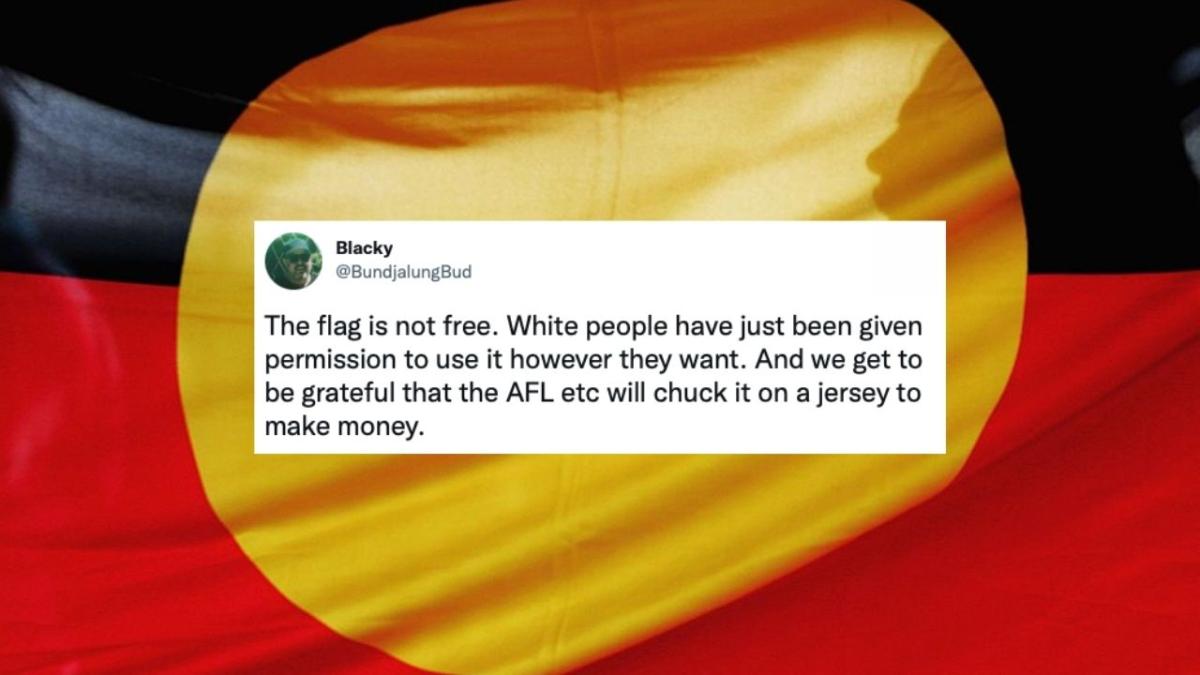
The Australian Government has spent $20 million to buy the rights to the Aboriginal flag, making it free for everyone to replicate and sell it — but some have pointed out that this news isn’t as positive as it may appear.
The fight to “free the flag” gained traction in the public consciousness after Luritija artist Harold Thomas (the flag’s creator) granted exclusive worldwide copyright license to produce the flag onto clothing to a non-Indigenous company named WAM Clothing in 2018.
WAM then controlled the use of the flag on clothing and its reproduction worldwide, and served cease and desist notices to Aboriginal-owned companies like Clothing The Gap for using images of the Aboriginal flag on their products.
Since then, Clothing The Gap and other organisations have been calling to “free the flag” so Aboriginal people can replicate and monetise their flag without the threat of legal action taken against them. Prime Minister Scott Morrison then confirmed the flag is now free for public use on Monday, to positive reactions from campaigners.
View this post on Instagram
Here’s the thing, though: opening up the flag copyright, while definitely beneficial to First Nations people who want to use it, also means everyone can reproduce the flag for money. Including white people and dodgy corporations who can profit off an identity that isn’t theirs.
Yep. I don’t see what there is to celebrate. https://t.co/aa9cvPCAnS
— Thomas Mayo (@thomasmayo23) January 24, 2022
https://twitter.com/BundjalungBud/status/1485696309281845249?s=20
https://twitter.com/BundjalungBud/status/1485716003837591552?s=20
Nah but I’m so glad the rest of you fullas are starting to come round; that flag stopped being ours the day old mate sold it to some wanda for a quick buck.
In the bin with it and his legacy 🚮
— Dr JM Field (@JM_Field5) January 24, 2022
And then there’s the questionable timing of this decision by the government and its symbolic nature.
scott morrison loves an Indigenous affairs announcement that makes whites feel like something deeply symbolic and powerful is happening while ensuring that zero actual substantive change has taken place
— bette midtier (@maximum_chips) January 24, 2022
First Nations commentators have taken to social media to criticise the government’s “freeing” of the Aboriginal flag as a distraction from actually creating meaningful change to the systemic racism and genocide this state perpetuates.
View this post on Instagram
IndigenousX founder and Gamilaroi man Luke Pearson took to Twitter to point out that the government was only dishing out symbols of progress, rather than actually creating meaningful change.
If your Indigenous affairs highlights consist solely of changing a word in an anthem that nobody was asking for and giving the Aboriginal flag to ‘all Australians’ I probably wouldn’t be too boastful about it…
— Pearson In The Wind (@LukeLPearson) January 24, 2022
Considering the news was announced two days before so-called Australia Day and given the government’s incompetence in pretty much every other aspect of its leadership, it sure looks like an attempt to to appear progressive.
Which is sinister and disingenuous considering the same government is still actively removing Aboriginal children from their families and allowing the destruction of culturally sacred sites.
Paired with the optics of the Australian government now owning the copyright to a flag that is a symbol of colonial resistance, well, it’s not exactly “free”.
This 👇
The Aboriginal Flag is now owned by the very entity it stands in resistance against. That’s not a good thing ppl!! https://t.co/J80aHLVeRm
— Jen Michels (@noturAboriginal) January 24, 2022
Noongar writer Claire G. Coleman penned a list of consequences of ‘”freeing” the flag on Twitter, dissecting the ramifications that others perhaps were’t aware of.
Don’t get me wrong, I think the situation with the Aboriginal Flag was the best possible outcome in the context. Sadly there will be consequences that none of you thought of, that some of us have been discussing for years. People just don’t think things through. A thread.
— Claire G. Coleman (@clairegcoleman) January 25, 2022
“Firstly, people demanded the flag be freed by the commonwealth acquiring it by financial or legal means. This result, what happened, gives power over our flag to the colonisers. Like I said, it was the only solution on offer but still far from perfect,” she wrote.
“I can guarantee that cheap t-shirts made in the 3rd world (possibly using slave labour) with our flag on them will hit the market within weeks. Blak businesses who want to sell flag products will not be able to compete.
“Don’t think that Blak businesses will be the ones doing this, because big business and countries with lower standards of living can out-compete any of us. It will not be our mob making the money from this, it will be EVERYBODY ELSE,” she warned.
The “free the flag” movement was based on a lie that we were not allowed to use, wave, or identify with our flag. We always had the use of the flag but we were not allowed to monetise it without permission. We now can but so can EVERYBODY.
— Claire G. Coleman (@clairegcoleman) January 25, 2022
Gunai and Gunditjmara woman and founder of Yarnda Consulting Meriki Onus also weighed in on the flag’s new status, essentially saying it’s complicated.
“I’m genuinely torn,” she wrote on Twitter, after comparing the flag saga to Israel obtaining the flag to Palestine, which it illegally occupies.
“I know a lot of people had good intentions behind it and black artists were treated like crap by WAM but on the other hand the federal government are literal colonisers. I wish the remedy was to place it into an Aboriginal controlled body.”
It’s important to note that wanting the Aboriginal flag freed and opposing the government aren’t necessarily opposing stances. You can be relieved for that First Nations business can sell merchandise without legal trouble, while still critical of the government’s intentions and weary of the wider ramifications its monopoly on the flag has.
If our government really cared about progress in the treatment of First Nations people, it would work on treaties, returning sovereignty, protecting native land and, you know, not committing genocide.
So far, we’re yet to see that.



